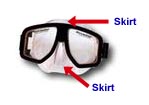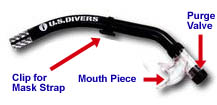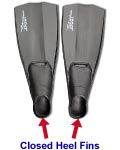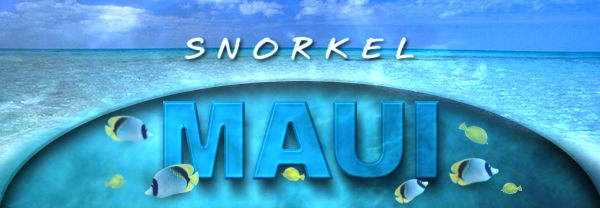|
1)
What is snorkeling?
2) What is the difference between snorkeling
and scuba diving?
3) Why do people snorkel?
4)
Is snorkeling safe?
5) But don't I need to be a good swimmer?
6) What equipment do you need to snorkel?
7) Hey! I have my equipment. What should I
do now?
8) Can you go underwater with a snorkel? What
if I want to get closer to things?
9) What conditions are good for snorkeling?
10) How do I take care of my equipment? How
should I store it?
1) What is snorkeling?
Snorkeling is swimming with fins, a mask, and a tube
called a snorkel that allows you to have your face down in
the water and still breathe.
2) What is the difference between
snorkeling and scuba diving?
Snorkeling doesn't require tanks and other expensive
equipment like regulators. Scuba diving allows you to breathe
underwater, while snorkeling allows you to breathe while you
are on the surface with your face down. Snorkeling
doesn't require any certification, while scuba diving requires
certification.
3) Why do people snorkel?
Because
it's loads of fun. : ) Fair enough?
4)
Is snorkeling safe?
One
of the wonderful things about snorkeling is that people of
all ages can participate. And one of the great things about
Maui and the other Hawaiian Islands is that there are many
great places for beginners to try out.
5) But don't I need to be a good swimmer?
Well
it sure can't hurt, but it's not required. It is recommended
that you do have some comfort and experience when you are
in water though. A few things to consider is that your fins
help you a great deal in terms of movement, and they float.
: ) As well, the mask that you wear will have air trapped
in it will helps you float as well. If you don't feel safe
enough, you can also rent floatation devices, as well as boogie
boards that you can lay on top of.
Many of the snorkeling spots on Maui on right off shore and
are in water less than 5 feet deep. It just depends which
sites that you go to, and your comfort level with water and
your equipment.
6) What equipment do you need to snorkel?
Well,
there are 3 main things that most snorkelers use.
A)
Mask
This is what you put on ummmm your face. This allows you to
see underwater without getting your eyes and nose wet. It's
important that the mask is a good fit when renting or buying
a mask. If the mask doesn't fit well, you will experience
some leakage of water in the mask.
| I
would highly recommend using a mask that has a "silicon
skirt". The skirt is the soft substance that is molded
to fit your face, and prevents water from entering the
mask. You can also rent or buy masks that use rubber ask
the skirt, but the seal is not nearly as good as the silicon,
and is quite simply a dated technology. Ask your local
snorkel or dive shop about choosing a mask that fits well.
They will know what to look for. |
 |
B) Snorkel
| Well,
this is what makes you a snorkeler. A snorkel is a hollow
curved tube that is placed in the mouth that allows you
to breathe while you are face down in the water. So basically,
while you looking down into the water, the snorkel is
sticking out of the water on one end while the other end
is in your mouth. When looking for a snorkel, I would
recommend asking for what is called a "purge"
snorkel. |

|
C) Fins
| This
is what makes life a lot of fun. Fins allow you to swim
like a fish. Yeeeha! There are 2 kinds of fins, but for
snorkeling in warm water, most people will do just fine
with the close heeled kind. The open heeled kind is more
for Scuba Divers which requires a special boot (bootie),
or for colder waters. Any ways, make sure that the fins
are a good fit, or else you will either be cutting off
circulation to your feet, or they will easily come off.
Make sure that they are a snug fit, but you should be
able to wiggle your toes. |
 |
7)
Hey! I have my equipment. What should I do now?
Well,
it's a good idea to get comfortable with your equipment before
you go out to the reef. Try out the equipment at your Hotel
pool. The first step is getting used to the mask. One thing
about masks is that they have a tendency to fog up. You can
either apply anti-fog goop (available at all snorkel shops)
to the inside of the mask, or you can use your own spit. It
sounds gross, but spit works quite well for preventing the
fogging up of your mask. Make sure that the spit/anti-fog
goop is spread across the full surface of the glass on the
inside of the mask. Now wash it out in the water. This should
prevent, or at least greatly reduce any fogging up of the
mask. When putting on the mask, make sure there are no hairs
stuck it between the silicon part of the mask. Hair will break
the seal that keeps the water from entering the mask. Also
keep the strap in the middle of the back of your head, and
don't have the strap too tight. Now, put on your mask and
look under water while you're standing up. You're looking
underwater. No fish yet, but soon...... Soon. ; )
Next,
attach the snorkel to your mask strap with the clip that's
on the snorkel. Put the snorkel in your mouth and breathe.
Don't try to breathe with your nose or else the mask will
quickly fog up. Breathe through your mouth in relaxed, normal
breaths. Now try breathing with your face in the water. Nothing
to it, right? Take as long as you want to get used to breathing
underwater. That's the biggest mental hurdle for first time
snorkelers. Are you comfortable yet?
If
so, put on your flippers and give it a try. With your face
down and body stretched out, start kicking with your fins.
Remember to keep your legs straight while you lightly kick.
You don't have to thrash around to swim well. Stay relaxed,
and swim around the pool, getting used to breathing, kicking,
and looking around.
8)
Can you go underwater with a snorkel?
What if I want to get closer to things?
Although many snorkelers dive underwater, I have found that
some people would rather not, or don't find the need to do
so. If you see a fish several feet below you though, and you
want to get a closer look, you'll have to dive down. By doing
this, your snorkel will fill up with water, and you will not
be able to breathe until you clear the passage of your snorkel
of water once you have resurfaced. It sounds a bit iffy, but
it's a common thing for more experienced snorkelers to dive
down and fill their snorkel with water.
To
clear the snorkel of water, you must resurface, give a good
strong blow of the snorkel as your head reaches the surface
once again, and the top of the snorkel has penetrated the
surface of the water. This should clear most if not all of
the water that has filled the snorkel, and allow you to breathe
normally through the snorkel once again. If you use what is
called a "purge" snorkel, (which I would recommend),
you will rarely get water back in your mouth. I would also
recommend trying this technique first in a pool.
Once
you get comfortable doing this as well as the other techniques
mentioned, you will feel more confident, and will have a more
positive relaxed experience out on the reef.
9)
What conditions are good for snorkeling?
The best times to go are when the waves are minimal, and it's
sunny outside.
Not only do large waves make things more challenging to get
around and potentially dangerous, but a disturbance such as
big waves also make the water murky, greatly decreasing visibility.
There are just some times when I've had to cancel a snorkeling
trip because the waves were to high. A good rule of thumb
is if there are surfers in the area, it's probably a bad day
or place to go snorkeling. Bays often offer more protection
from a surge (big waves). The ideal snorkeling conditions
are waves at 0-1 feet. Listen to the radio for a marine forecast,
which should mention these kind of conditions.
It's also best to go snorkeling when the sun is out. Sunlight
increases visibility, and brings out the true colors of fish
and coral. It brings out the 'wow' factor for fish and overall
experience. But the sun also brings out the 'sun burn' factor.
If you're not wearing some sort of wet suit, shorty, or other
coverings, make sure that you've got your back, neck, shoulders,
butt, and thighs covered in sun block. To make things a bit
easier, I would often just wear an old junky shirt.
10) How do I take care of my equipment?
How should I store it?
Protect your equipment from light, heat and fumes. Sunlight
is known to damage the silicon parts of the mask, making the
seal brittle. Heat also degrades the mask, as well as snorkel.
After you finish snorkeling, make sure your equipment gets
washed off with fresh water. Salt water that dries will start
wearing away at your equipment. Many beaches will have a place
to do this. If not on the beach, make sure you wash the equipment
off back in your hotel room that day.
It's also a good idea to wash your mask lens with soap or
toothpaste every once in a while. This washes away any grease
that causes your mask to fog up. Just make sure that you've
washed it out good so there is no residue.
Don't pile heavy objects on top of any of your equipment.
Prolonged weight on top of a mask, snorkel, or fins can warp
them. To avoid bent fins, they should lie flat, and not on
their tips. Keep walking in your fins on land to a minimum.
|


